Assessment Task 1- Organisational Requirements
VerifiedAdded on 2023/03/17
|16
|2439
|43
AI Summary
This document provides an assessment task on organisational requirements for Charity Care Pty. Ltd. It includes a survey form, current compliance requirements, compliance management, comparison of available compliance systems, research process, and recommendations.
Contribute Materials
Your contribution can guide someone’s learning journey. Share your
documents today.
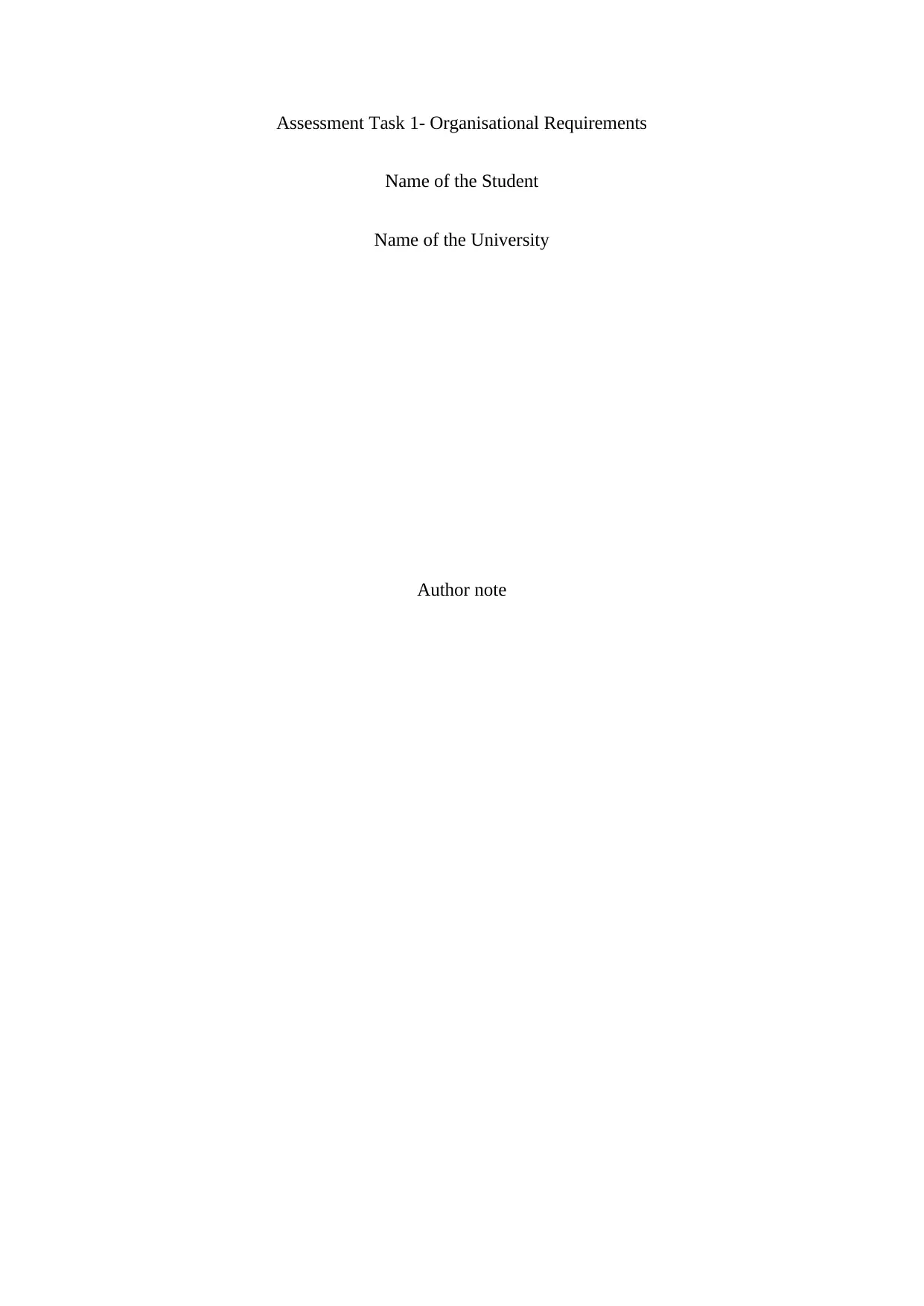
Assessment Task 1- Organisational Requirements
Name of the Student
Name of the University
Author note
Name of the Student
Name of the University
Author note
Secure Best Marks with AI Grader
Need help grading? Try our AI Grader for instant feedback on your assignments.
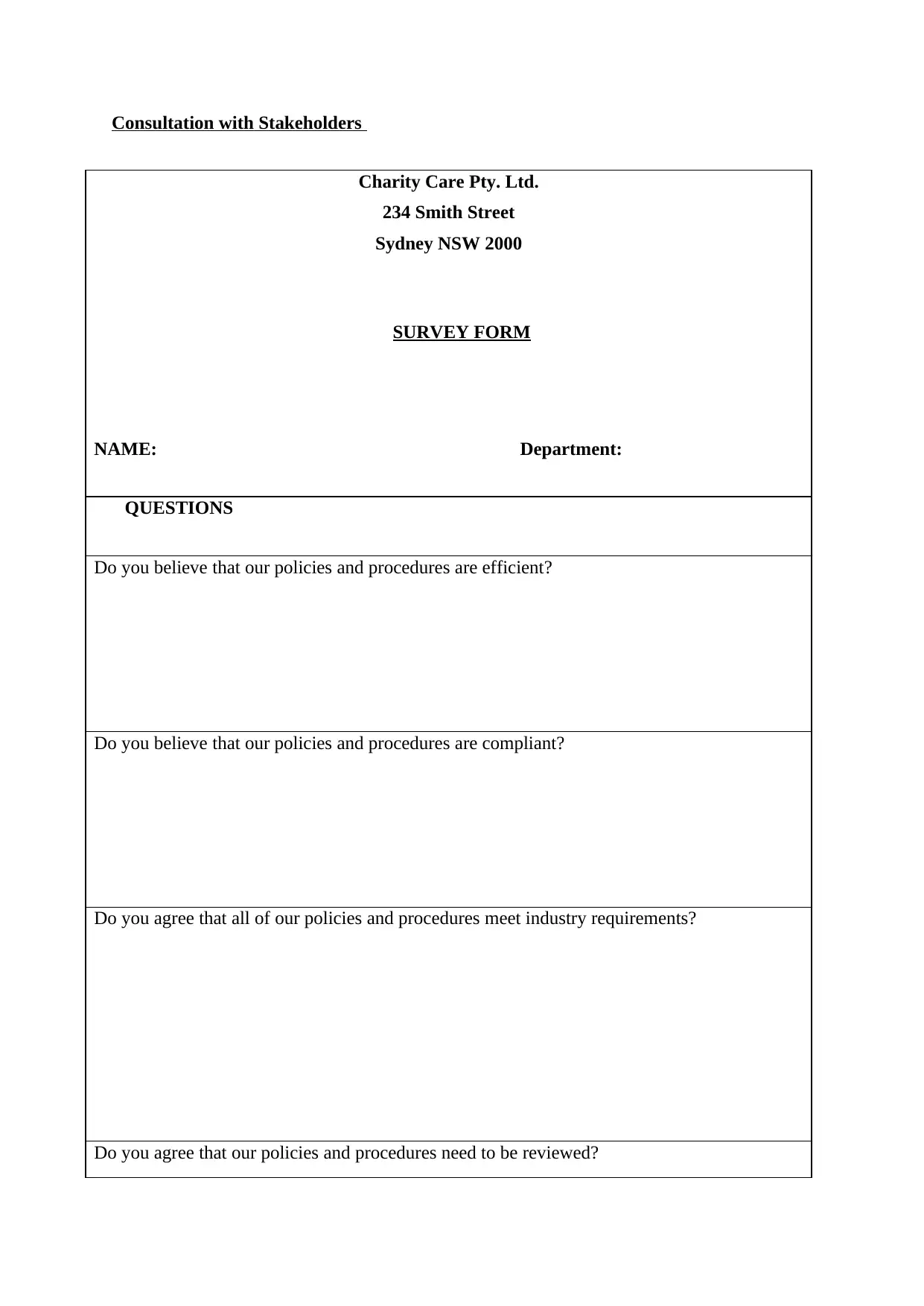
Consultation with Stakeholders
Charity Care Pty. Ltd.
234 Smith Street
Sydney NSW 2000
SURVEY FORM
NAME: Department:
QUESTIONS
Do you believe that our policies and procedures are efficient?
Do you believe that our policies and procedures are compliant?
Do you agree that all of our policies and procedures meet industry requirements?
Do you agree that our policies and procedures need to be reviewed?
Charity Care Pty. Ltd.
234 Smith Street
Sydney NSW 2000
SURVEY FORM
NAME: Department:
QUESTIONS
Do you believe that our policies and procedures are efficient?
Do you believe that our policies and procedures are compliant?
Do you agree that all of our policies and procedures meet industry requirements?
Do you agree that our policies and procedures need to be reviewed?
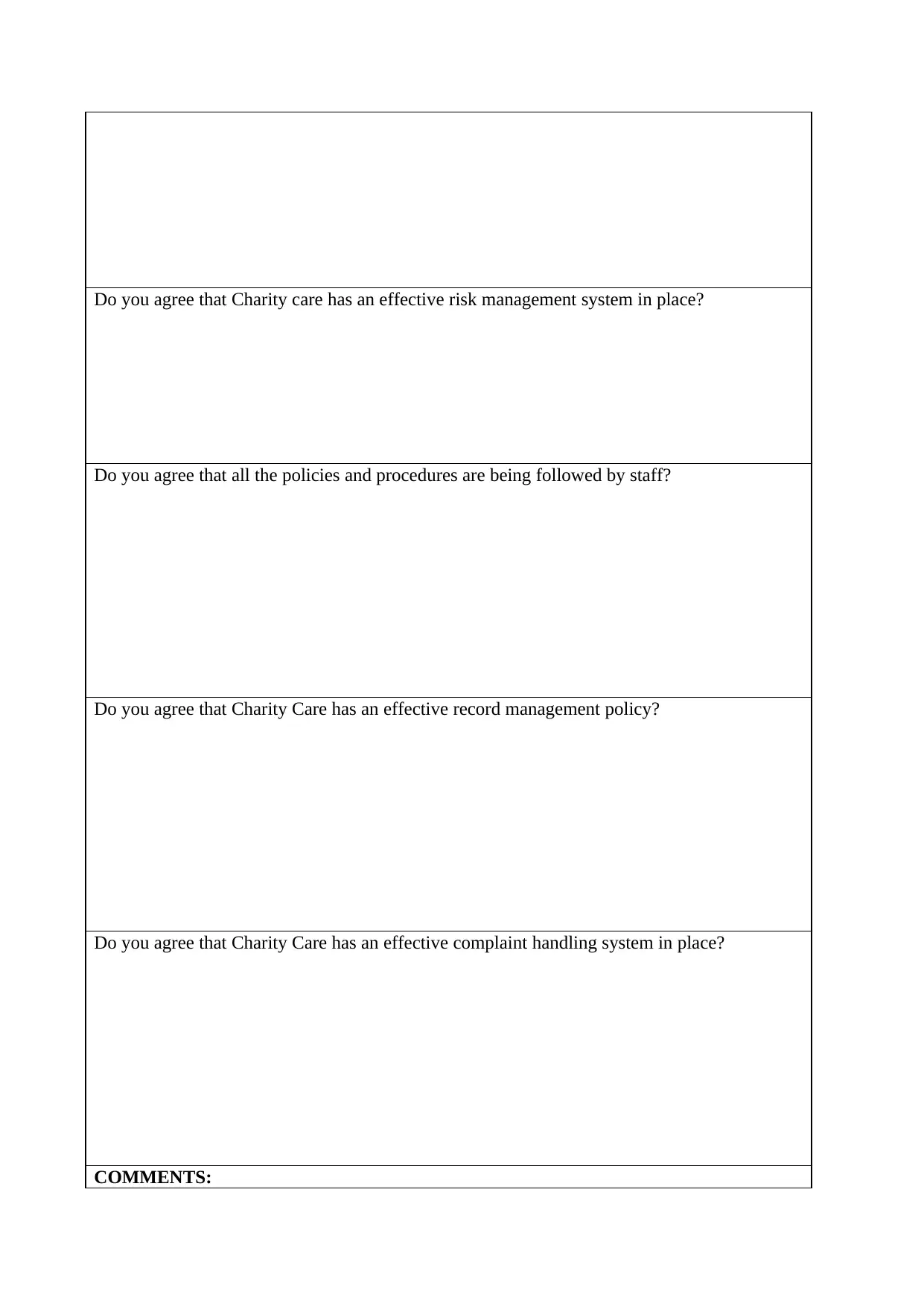
Do you agree that Charity care has an effective risk management system in place?
Do you agree that all the policies and procedures are being followed by staff?
Do you agree that Charity Care has an effective record management policy?
Do you agree that Charity Care has an effective complaint handling system in place?
COMMENTS:
Do you agree that all the policies and procedures are being followed by staff?
Do you agree that Charity Care has an effective record management policy?
Do you agree that Charity Care has an effective complaint handling system in place?
COMMENTS:
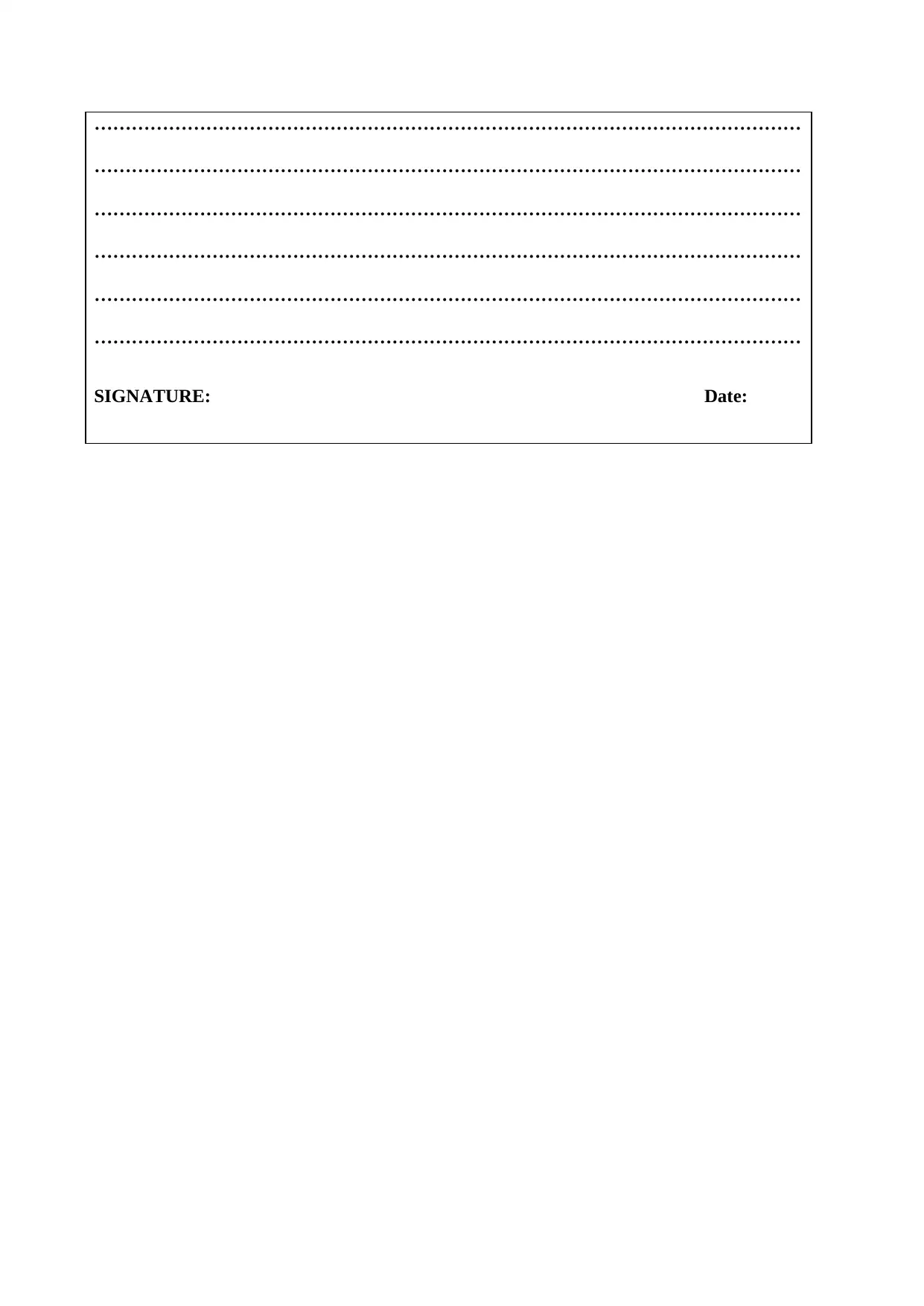
……………………………………………………………………………………………………
……………………………………………………………………………………………………
……………………………………………………………………………………………………
……………………………………………………………………………………………………
……………………………………………………………………………………………………
……………………………………………………………………………………………………
SIGNATURE: Date:
……………………………………………………………………………………………………
……………………………………………………………………………………………………
……………………………………………………………………………………………………
……………………………………………………………………………………………………
……………………………………………………………………………………………………
SIGNATURE: Date:
Secure Best Marks with AI Grader
Need help grading? Try our AI Grader for instant feedback on your assignments.
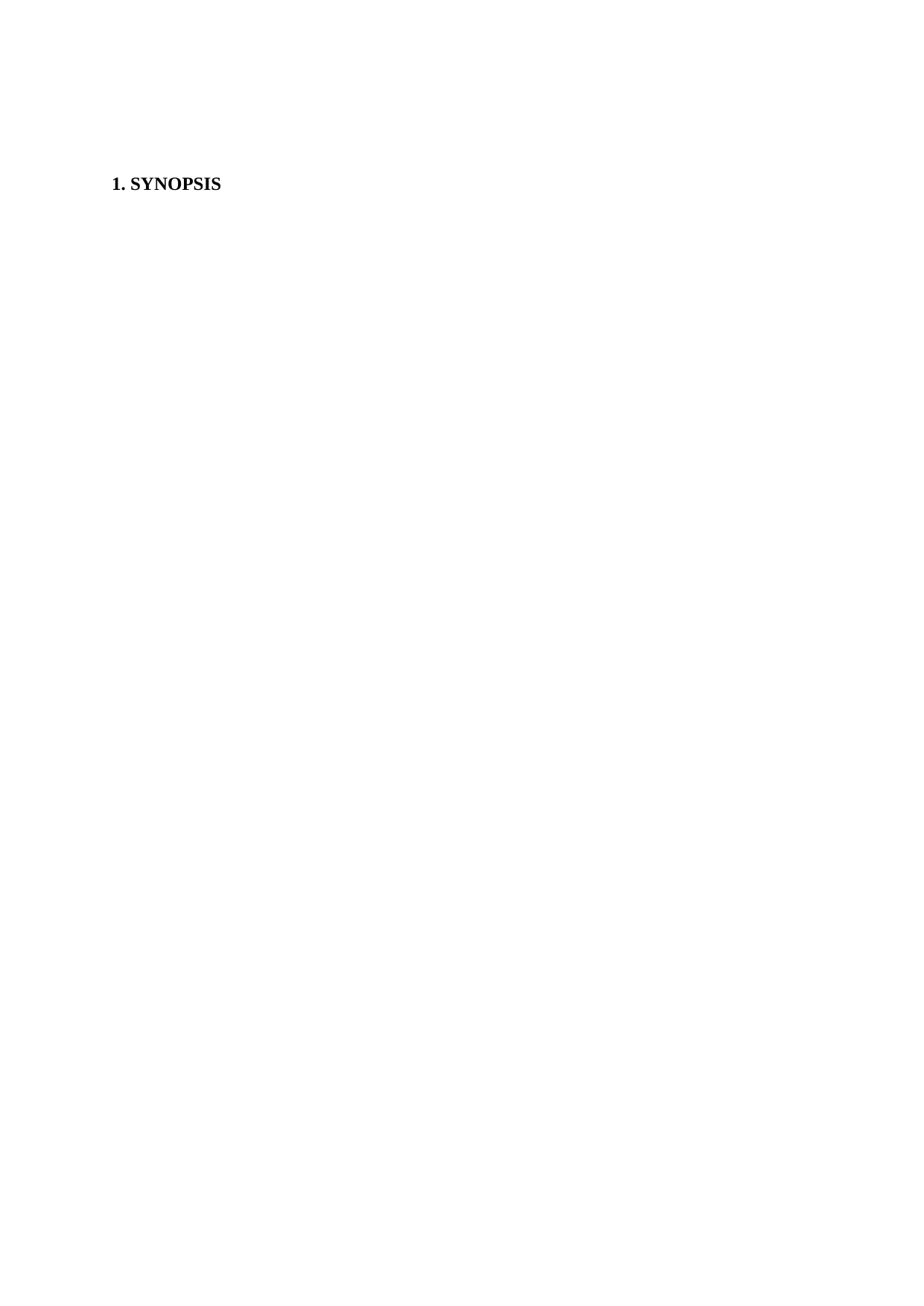
1. SYNOPSIS
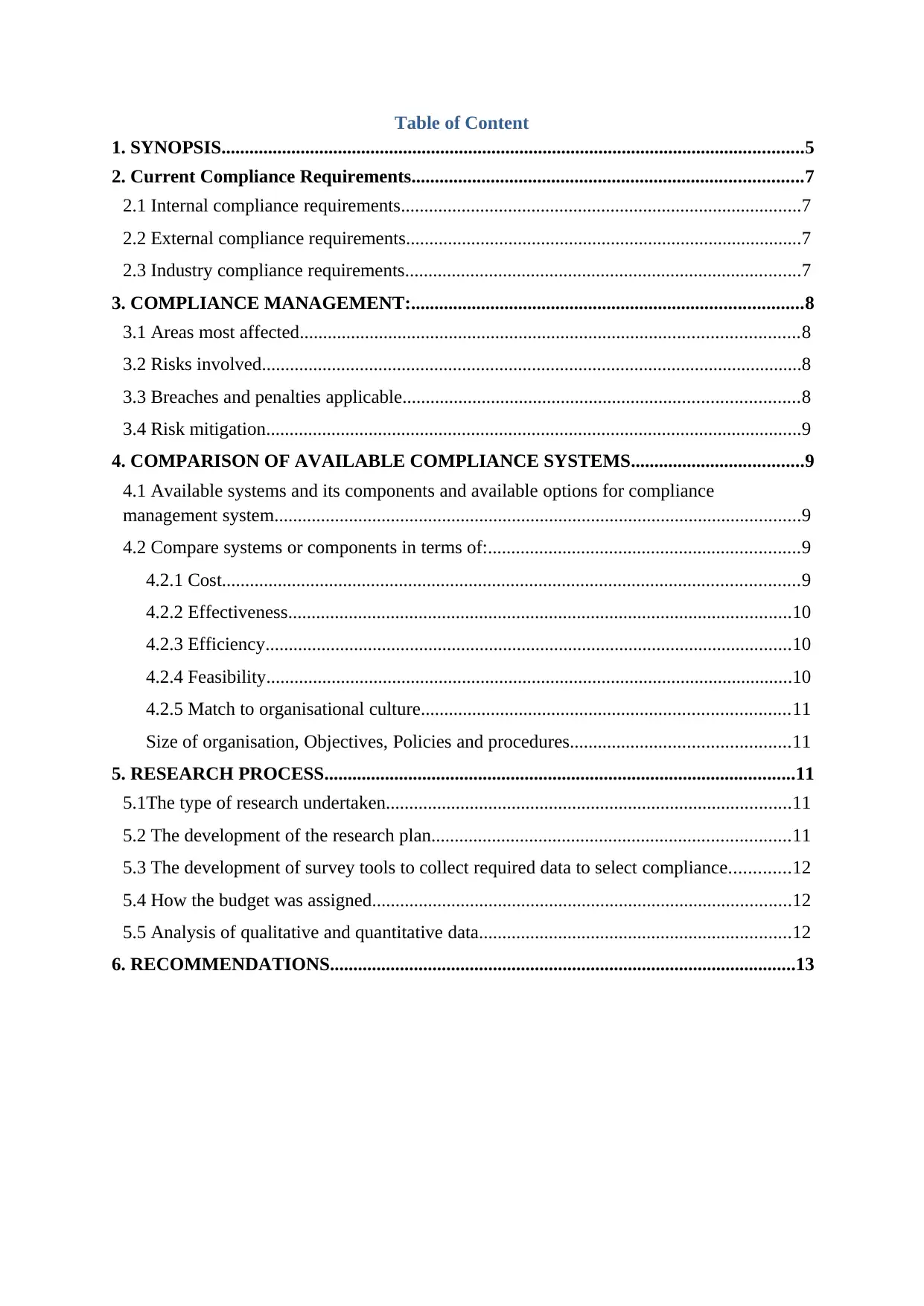
Table of Content
1. SYNOPSIS.............................................................................................................................5
2. Current Compliance Requirements....................................................................................7
2.1 Internal compliance requirements......................................................................................7
2.2 External compliance requirements.....................................................................................7
2.3 Industry compliance requirements.....................................................................................7
3. COMPLIANCE MANAGEMENT:....................................................................................8
3.1 Areas most affected...........................................................................................................8
3.2 Risks involved....................................................................................................................8
3.3 Breaches and penalties applicable.....................................................................................8
3.4 Risk mitigation...................................................................................................................9
4. COMPARISON OF AVAILABLE COMPLIANCE SYSTEMS.....................................9
4.1 Available systems and its components and available options for compliance
management system.................................................................................................................9
4.2 Compare systems or components in terms of:...................................................................9
4.2.1 Cost............................................................................................................................9
4.2.2 Effectiveness............................................................................................................10
4.2.3 Efficiency.................................................................................................................10
4.2.4 Feasibility.................................................................................................................10
4.2.5 Match to organisational culture...............................................................................11
Size of organisation, Objectives, Policies and procedures...............................................11
5. RESEARCH PROCESS.....................................................................................................11
5.1The type of research undertaken.......................................................................................11
5.2 The development of the research plan.............................................................................11
5.3 The development of survey tools to collect required data to select compliance.............12
5.4 How the budget was assigned..........................................................................................12
5.5 Analysis of qualitative and quantitative data...................................................................12
6. RECOMMENDATIONS....................................................................................................13
1. SYNOPSIS.............................................................................................................................5
2. Current Compliance Requirements....................................................................................7
2.1 Internal compliance requirements......................................................................................7
2.2 External compliance requirements.....................................................................................7
2.3 Industry compliance requirements.....................................................................................7
3. COMPLIANCE MANAGEMENT:....................................................................................8
3.1 Areas most affected...........................................................................................................8
3.2 Risks involved....................................................................................................................8
3.3 Breaches and penalties applicable.....................................................................................8
3.4 Risk mitigation...................................................................................................................9
4. COMPARISON OF AVAILABLE COMPLIANCE SYSTEMS.....................................9
4.1 Available systems and its components and available options for compliance
management system.................................................................................................................9
4.2 Compare systems or components in terms of:...................................................................9
4.2.1 Cost............................................................................................................................9
4.2.2 Effectiveness............................................................................................................10
4.2.3 Efficiency.................................................................................................................10
4.2.4 Feasibility.................................................................................................................10
4.2.5 Match to organisational culture...............................................................................11
Size of organisation, Objectives, Policies and procedures...............................................11
5. RESEARCH PROCESS.....................................................................................................11
5.1The type of research undertaken.......................................................................................11
5.2 The development of the research plan.............................................................................11
5.3 The development of survey tools to collect required data to select compliance.............12
5.4 How the budget was assigned..........................................................................................12
5.5 Analysis of qualitative and quantitative data...................................................................12
6. RECOMMENDATIONS....................................................................................................13
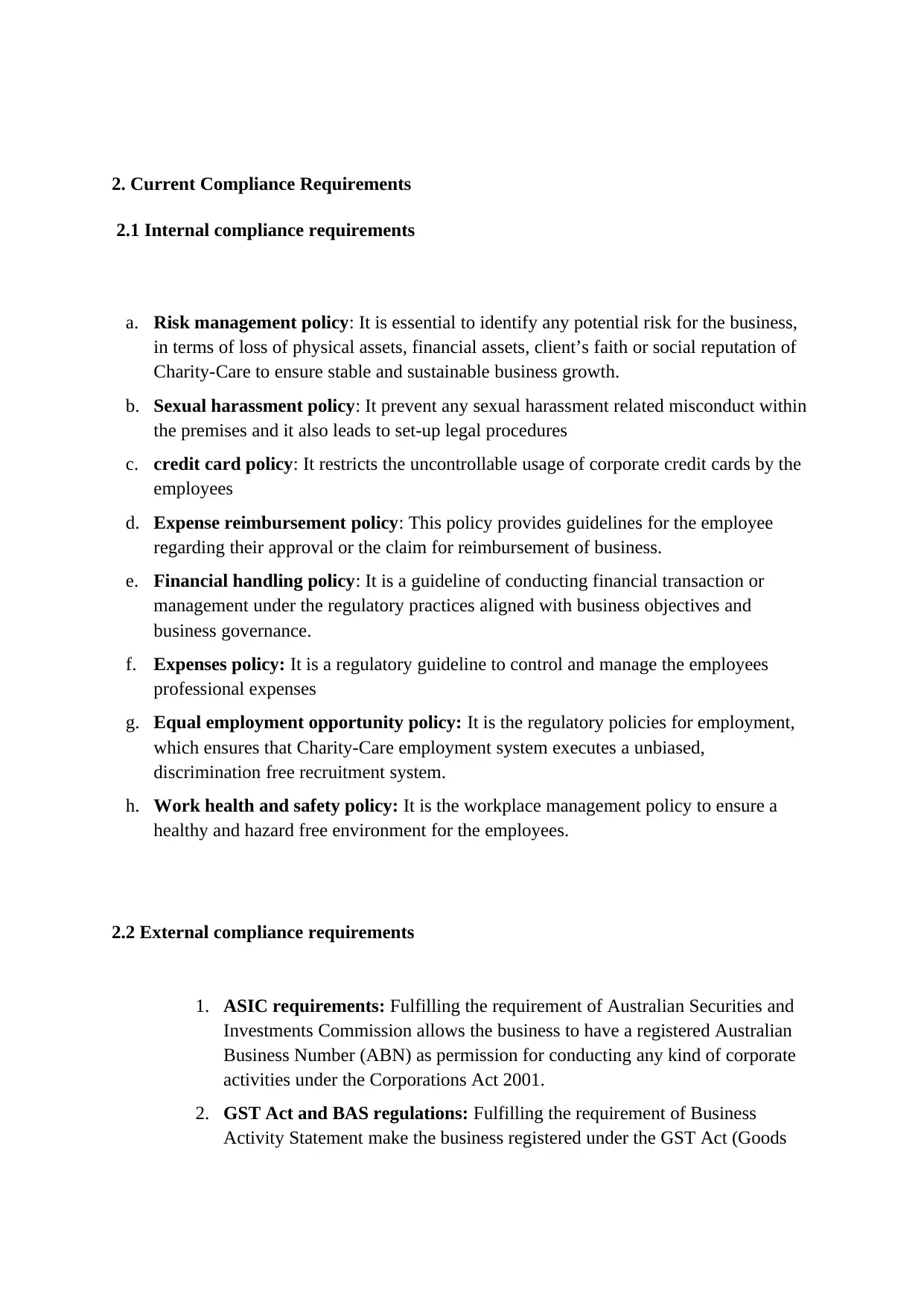
2. Current Compliance Requirements
2.1 Internal compliance requirements
a. Risk management policy: It is essential to identify any potential risk for the business,
in terms of loss of physical assets, financial assets, client’s faith or social reputation of
Charity-Care to ensure stable and sustainable business growth.
b. Sexual harassment policy: It prevent any sexual harassment related misconduct within
the premises and it also leads to set-up legal procedures
c. credit card policy: It restricts the uncontrollable usage of corporate credit cards by the
employees
d. Expense reimbursement policy: This policy provides guidelines for the employee
regarding their approval or the claim for reimbursement of business.
e. Financial handling policy: It is a guideline of conducting financial transaction or
management under the regulatory practices aligned with business objectives and
business governance.
f. Expenses policy: It is a regulatory guideline to control and manage the employees
professional expenses
g. Equal employment opportunity policy: It is the regulatory policies for employment,
which ensures that Charity-Care employment system executes a unbiased,
discrimination free recruitment system.
h. Work health and safety policy: It is the workplace management policy to ensure a
healthy and hazard free environment for the employees.
2.2 External compliance requirements
1. ASIC requirements: Fulfilling the requirement of Australian Securities and
Investments Commission allows the business to have a registered Australian
Business Number (ABN) as permission for conducting any kind of corporate
activities under the Corporations Act 2001.
2. GST Act and BAS regulations: Fulfilling the requirement of Business
Activity Statement make the business registered under the GST Act (Goods
2.1 Internal compliance requirements
a. Risk management policy: It is essential to identify any potential risk for the business,
in terms of loss of physical assets, financial assets, client’s faith or social reputation of
Charity-Care to ensure stable and sustainable business growth.
b. Sexual harassment policy: It prevent any sexual harassment related misconduct within
the premises and it also leads to set-up legal procedures
c. credit card policy: It restricts the uncontrollable usage of corporate credit cards by the
employees
d. Expense reimbursement policy: This policy provides guidelines for the employee
regarding their approval or the claim for reimbursement of business.
e. Financial handling policy: It is a guideline of conducting financial transaction or
management under the regulatory practices aligned with business objectives and
business governance.
f. Expenses policy: It is a regulatory guideline to control and manage the employees
professional expenses
g. Equal employment opportunity policy: It is the regulatory policies for employment,
which ensures that Charity-Care employment system executes a unbiased,
discrimination free recruitment system.
h. Work health and safety policy: It is the workplace management policy to ensure a
healthy and hazard free environment for the employees.
2.2 External compliance requirements
1. ASIC requirements: Fulfilling the requirement of Australian Securities and
Investments Commission allows the business to have a registered Australian
Business Number (ABN) as permission for conducting any kind of corporate
activities under the Corporations Act 2001.
2. GST Act and BAS regulations: Fulfilling the requirement of Business
Activity Statement make the business registered under the GST Act (Goods
Paraphrase This Document
Need a fresh take? Get an instant paraphrase of this document with our AI Paraphraser
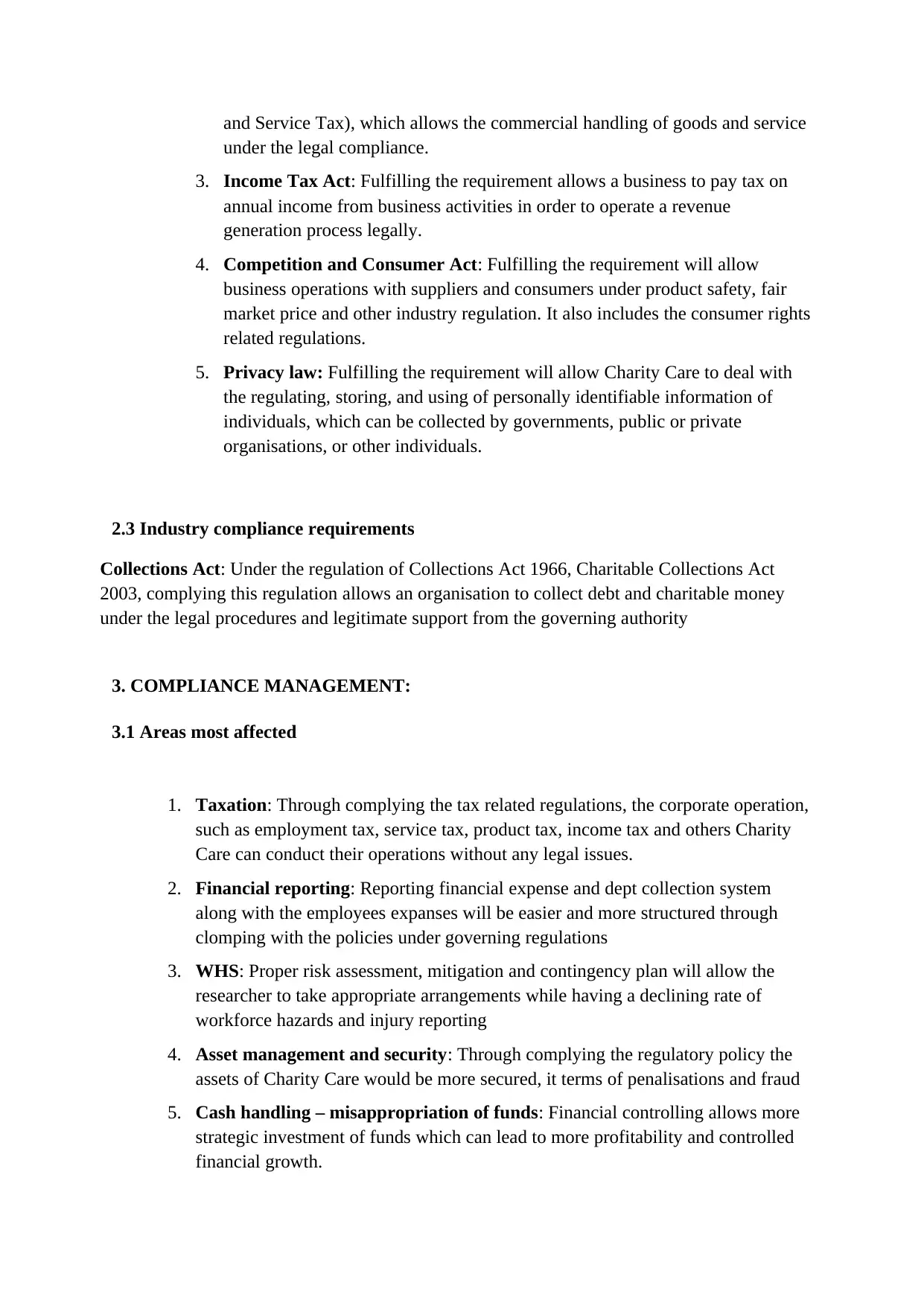
and Service Tax), which allows the commercial handling of goods and service
under the legal compliance.
3. Income Tax Act: Fulfilling the requirement allows a business to pay tax on
annual income from business activities in order to operate a revenue
generation process legally.
4. Competition and Consumer Act: Fulfilling the requirement will allow
business operations with suppliers and consumers under product safety, fair
market price and other industry regulation. It also includes the consumer rights
related regulations.
5. Privacy law: Fulfilling the requirement will allow Charity Care to deal with
the regulating, storing, and using of personally identifiable information of
individuals, which can be collected by governments, public or private
organisations, or other individuals.
2.3 Industry compliance requirements
Collections Act: Under the regulation of Collections Act 1966, Charitable Collections Act
2003, complying this regulation allows an organisation to collect debt and charitable money
under the legal procedures and legitimate support from the governing authority
3. COMPLIANCE MANAGEMENT:
3.1 Areas most affected
1. Taxation: Through complying the tax related regulations, the corporate operation,
such as employment tax, service tax, product tax, income tax and others Charity
Care can conduct their operations without any legal issues.
2. Financial reporting: Reporting financial expense and dept collection system
along with the employees expanses will be easier and more structured through
clomping with the policies under governing regulations
3. WHS: Proper risk assessment, mitigation and contingency plan will allow the
researcher to take appropriate arrangements while having a declining rate of
workforce hazards and injury reporting
4. Asset management and security: Through complying the regulatory policy the
assets of Charity Care would be more secured, it terms of penalisations and fraud
5. Cash handling – misappropriation of funds: Financial controlling allows more
strategic investment of funds which can lead to more profitability and controlled
financial growth.
under the legal compliance.
3. Income Tax Act: Fulfilling the requirement allows a business to pay tax on
annual income from business activities in order to operate a revenue
generation process legally.
4. Competition and Consumer Act: Fulfilling the requirement will allow
business operations with suppliers and consumers under product safety, fair
market price and other industry regulation. It also includes the consumer rights
related regulations.
5. Privacy law: Fulfilling the requirement will allow Charity Care to deal with
the regulating, storing, and using of personally identifiable information of
individuals, which can be collected by governments, public or private
organisations, or other individuals.
2.3 Industry compliance requirements
Collections Act: Under the regulation of Collections Act 1966, Charitable Collections Act
2003, complying this regulation allows an organisation to collect debt and charitable money
under the legal procedures and legitimate support from the governing authority
3. COMPLIANCE MANAGEMENT:
3.1 Areas most affected
1. Taxation: Through complying the tax related regulations, the corporate operation,
such as employment tax, service tax, product tax, income tax and others Charity
Care can conduct their operations without any legal issues.
2. Financial reporting: Reporting financial expense and dept collection system
along with the employees expanses will be easier and more structured through
clomping with the policies under governing regulations
3. WHS: Proper risk assessment, mitigation and contingency plan will allow the
researcher to take appropriate arrangements while having a declining rate of
workforce hazards and injury reporting
4. Asset management and security: Through complying the regulatory policy the
assets of Charity Care would be more secured, it terms of penalisations and fraud
5. Cash handling – misappropriation of funds: Financial controlling allows more
strategic investment of funds which can lead to more profitability and controlled
financial growth.
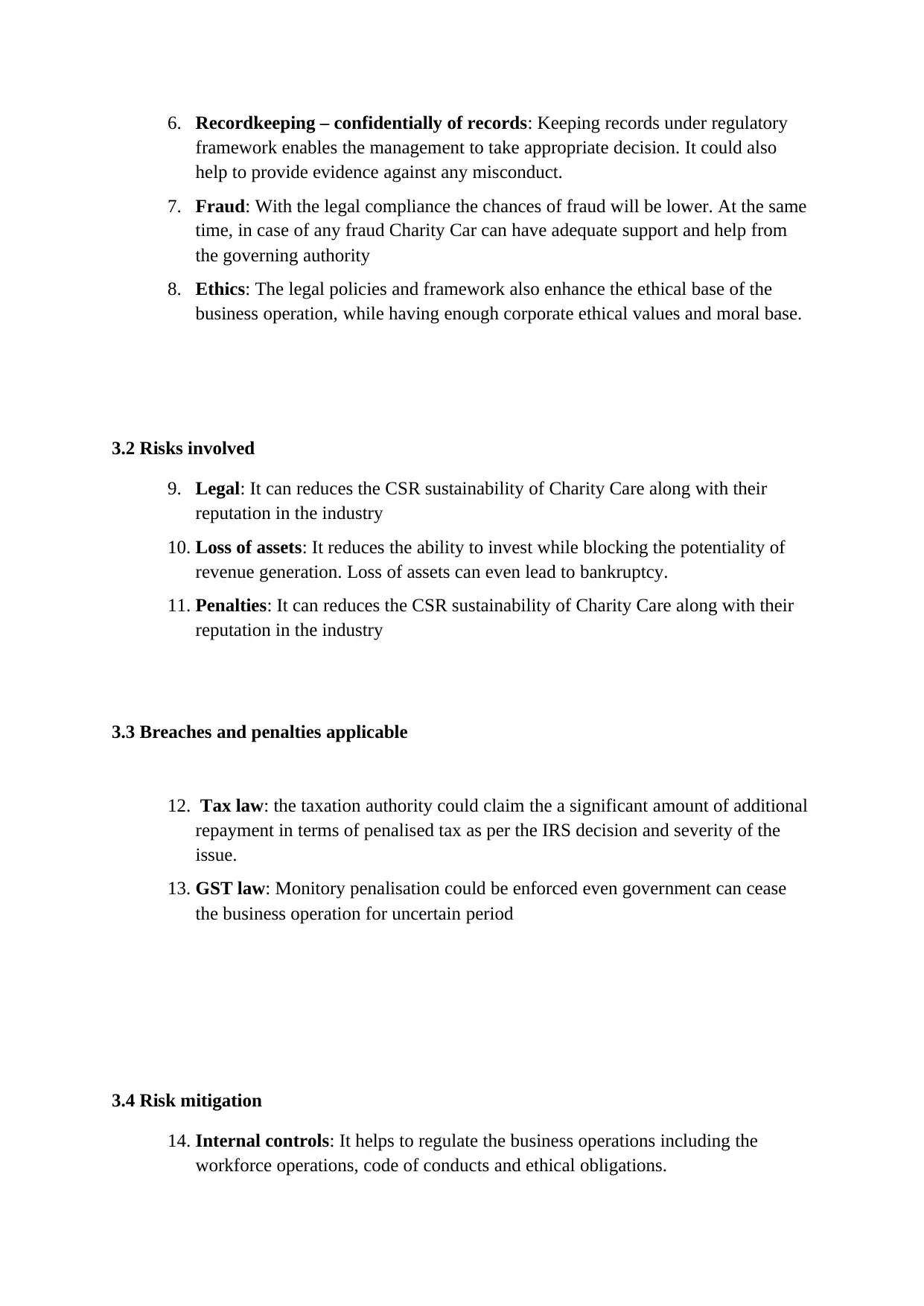
6. Recordkeeping – confidentially of records: Keeping records under regulatory
framework enables the management to take appropriate decision. It could also
help to provide evidence against any misconduct.
7. Fraud: With the legal compliance the chances of fraud will be lower. At the same
time, in case of any fraud Charity Car can have adequate support and help from
the governing authority
8. Ethics: The legal policies and framework also enhance the ethical base of the
business operation, while having enough corporate ethical values and moral base.
3.2 Risks involved
9. Legal: It can reduces the CSR sustainability of Charity Care along with their
reputation in the industry
10. Loss of assets: It reduces the ability to invest while blocking the potentiality of
revenue generation. Loss of assets can even lead to bankruptcy.
11. Penalties: It can reduces the CSR sustainability of Charity Care along with their
reputation in the industry
3.3 Breaches and penalties applicable
12. Tax law: the taxation authority could claim the a significant amount of additional
repayment in terms of penalised tax as per the IRS decision and severity of the
issue.
13. GST law: Monitory penalisation could be enforced even government can cease
the business operation for uncertain period
3.4 Risk mitigation
14. Internal controls: It helps to regulate the business operations including the
workforce operations, code of conducts and ethical obligations.
framework enables the management to take appropriate decision. It could also
help to provide evidence against any misconduct.
7. Fraud: With the legal compliance the chances of fraud will be lower. At the same
time, in case of any fraud Charity Car can have adequate support and help from
the governing authority
8. Ethics: The legal policies and framework also enhance the ethical base of the
business operation, while having enough corporate ethical values and moral base.
3.2 Risks involved
9. Legal: It can reduces the CSR sustainability of Charity Care along with their
reputation in the industry
10. Loss of assets: It reduces the ability to invest while blocking the potentiality of
revenue generation. Loss of assets can even lead to bankruptcy.
11. Penalties: It can reduces the CSR sustainability of Charity Care along with their
reputation in the industry
3.3 Breaches and penalties applicable
12. Tax law: the taxation authority could claim the a significant amount of additional
repayment in terms of penalised tax as per the IRS decision and severity of the
issue.
13. GST law: Monitory penalisation could be enforced even government can cease
the business operation for uncertain period
3.4 Risk mitigation
14. Internal controls: It helps to regulate the business operations including the
workforce operations, code of conducts and ethical obligations.
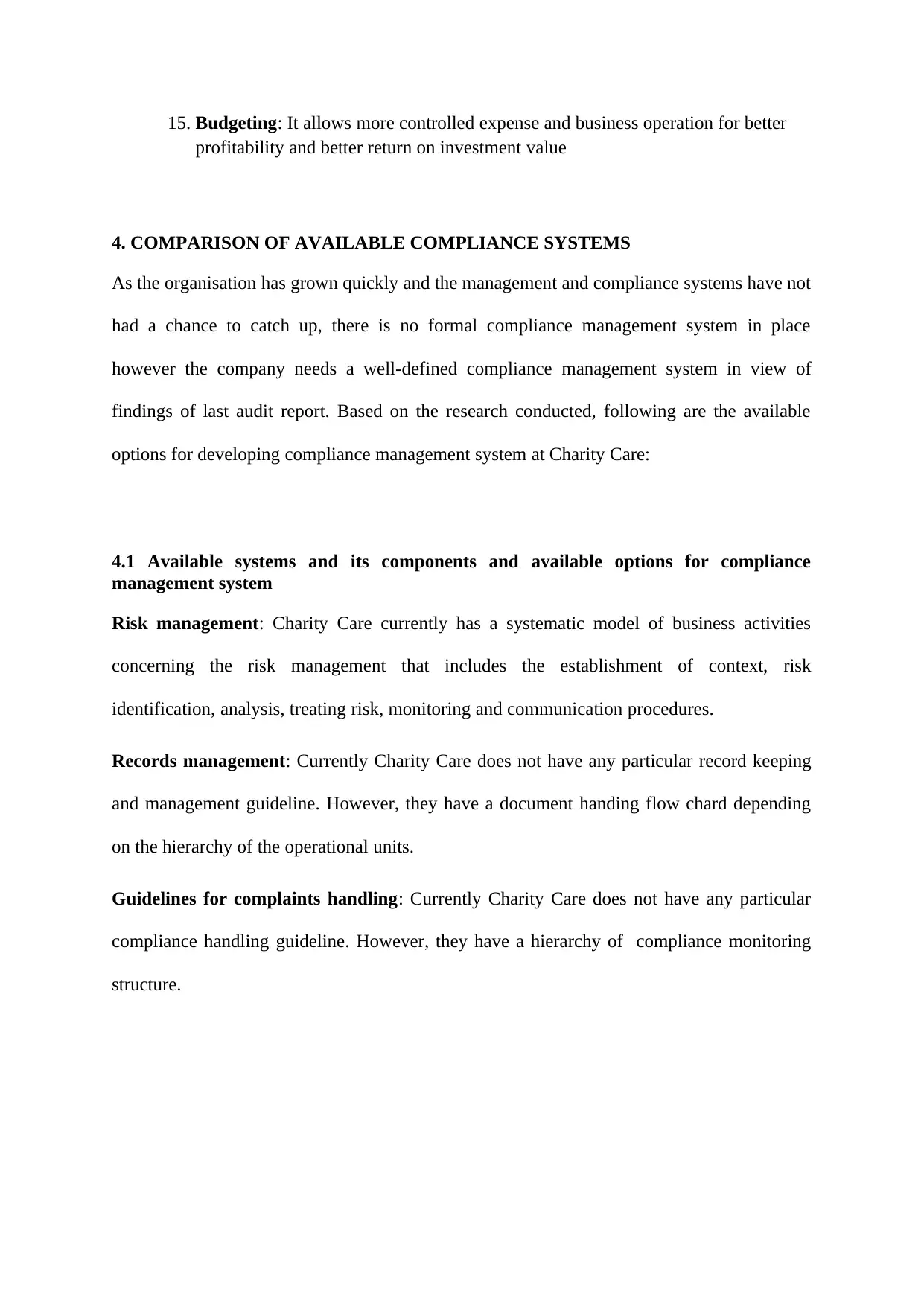
15. Budgeting: It allows more controlled expense and business operation for better
profitability and better return on investment value
4. COMPARISON OF AVAILABLE COMPLIANCE SYSTEMS
As the organisation has grown quickly and the management and compliance systems have not
had a chance to catch up, there is no formal compliance management system in place
however the company needs a well-defined compliance management system in view of
findings of last audit report. Based on the research conducted, following are the available
options for developing compliance management system at Charity Care:
4.1 Available systems and its components and available options for compliance
management system
Risk management: Charity Care currently has a systematic model of business activities
concerning the risk management that includes the establishment of context, risk
identification, analysis, treating risk, monitoring and communication procedures.
Records management: Currently Charity Care does not have any particular record keeping
and management guideline. However, they have a document handing flow chard depending
on the hierarchy of the operational units.
Guidelines for complaints handling: Currently Charity Care does not have any particular
compliance handling guideline. However, they have a hierarchy of compliance monitoring
structure.
profitability and better return on investment value
4. COMPARISON OF AVAILABLE COMPLIANCE SYSTEMS
As the organisation has grown quickly and the management and compliance systems have not
had a chance to catch up, there is no formal compliance management system in place
however the company needs a well-defined compliance management system in view of
findings of last audit report. Based on the research conducted, following are the available
options for developing compliance management system at Charity Care:
4.1 Available systems and its components and available options for compliance
management system
Risk management: Charity Care currently has a systematic model of business activities
concerning the risk management that includes the establishment of context, risk
identification, analysis, treating risk, monitoring and communication procedures.
Records management: Currently Charity Care does not have any particular record keeping
and management guideline. However, they have a document handing flow chard depending
on the hierarchy of the operational units.
Guidelines for complaints handling: Currently Charity Care does not have any particular
compliance handling guideline. However, they have a hierarchy of compliance monitoring
structure.
Secure Best Marks with AI Grader
Need help grading? Try our AI Grader for instant feedback on your assignments.
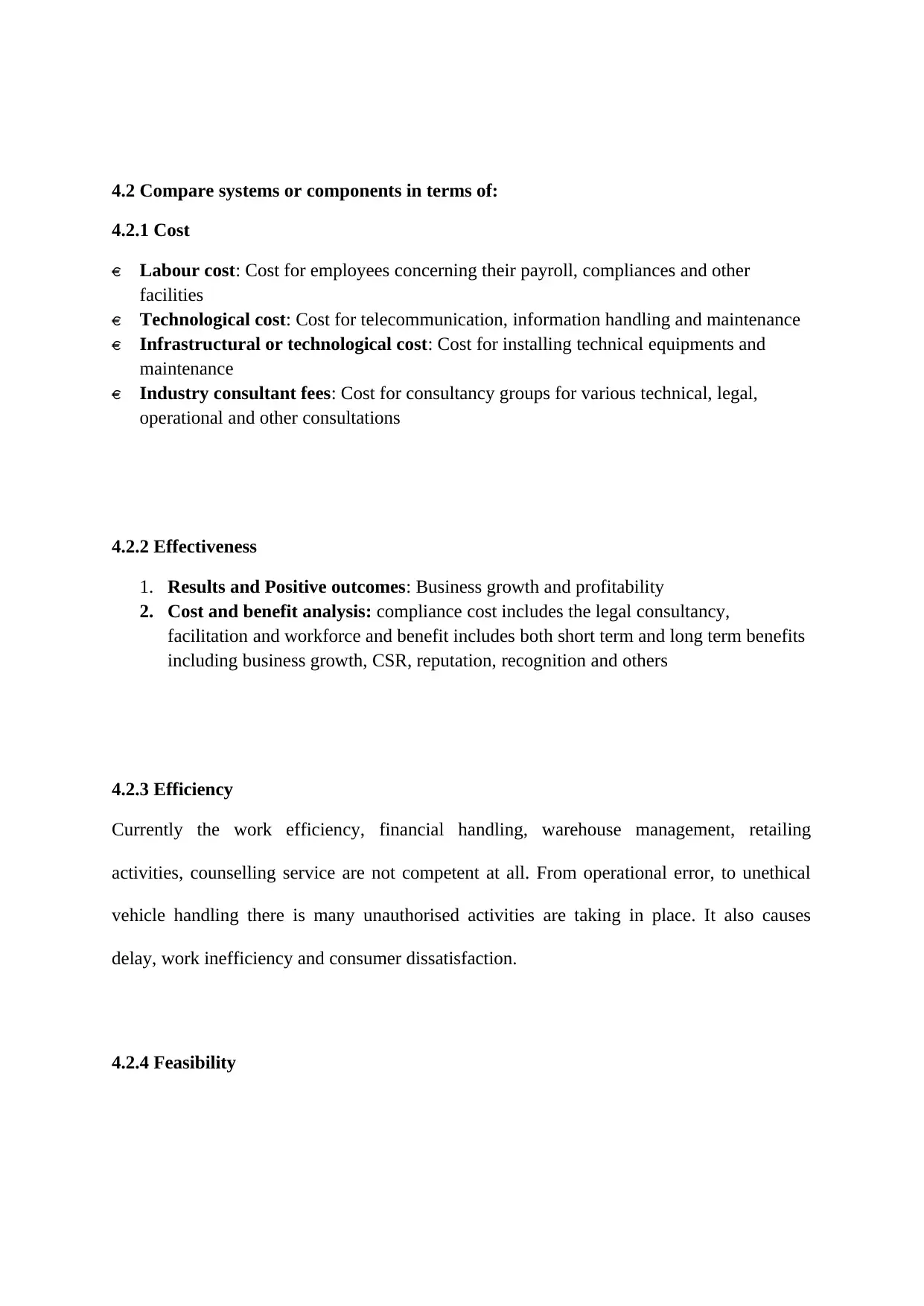
4.2 Compare systems or components in terms of:
4.2.1 Cost
Labour cost: Cost for employees concerning their payroll, compliances and other
facilities
Technological cost: Cost for telecommunication, information handling and maintenance
Infrastructural or technological cost: Cost for installing technical equipments and
maintenance
Industry consultant fees: Cost for consultancy groups for various technical, legal,
operational and other consultations
4.2.2 Effectiveness
1. Results and Positive outcomes: Business growth and profitability
2. Cost and benefit analysis: compliance cost includes the legal consultancy,
facilitation and workforce and benefit includes both short term and long term benefits
including business growth, CSR, reputation, recognition and others
4.2.3 Efficiency
Currently the work efficiency, financial handling, warehouse management, retailing
activities, counselling service are not competent at all. From operational error, to unethical
vehicle handling there is many unauthorised activities are taking in place. It also causes
delay, work inefficiency and consumer dissatisfaction.
4.2.4 Feasibility
4.2.1 Cost
Labour cost: Cost for employees concerning their payroll, compliances and other
facilities
Technological cost: Cost for telecommunication, information handling and maintenance
Infrastructural or technological cost: Cost for installing technical equipments and
maintenance
Industry consultant fees: Cost for consultancy groups for various technical, legal,
operational and other consultations
4.2.2 Effectiveness
1. Results and Positive outcomes: Business growth and profitability
2. Cost and benefit analysis: compliance cost includes the legal consultancy,
facilitation and workforce and benefit includes both short term and long term benefits
including business growth, CSR, reputation, recognition and others
4.2.3 Efficiency
Currently the work efficiency, financial handling, warehouse management, retailing
activities, counselling service are not competent at all. From operational error, to unethical
vehicle handling there is many unauthorised activities are taking in place. It also causes
delay, work inefficiency and consumer dissatisfaction.
4.2.4 Feasibility
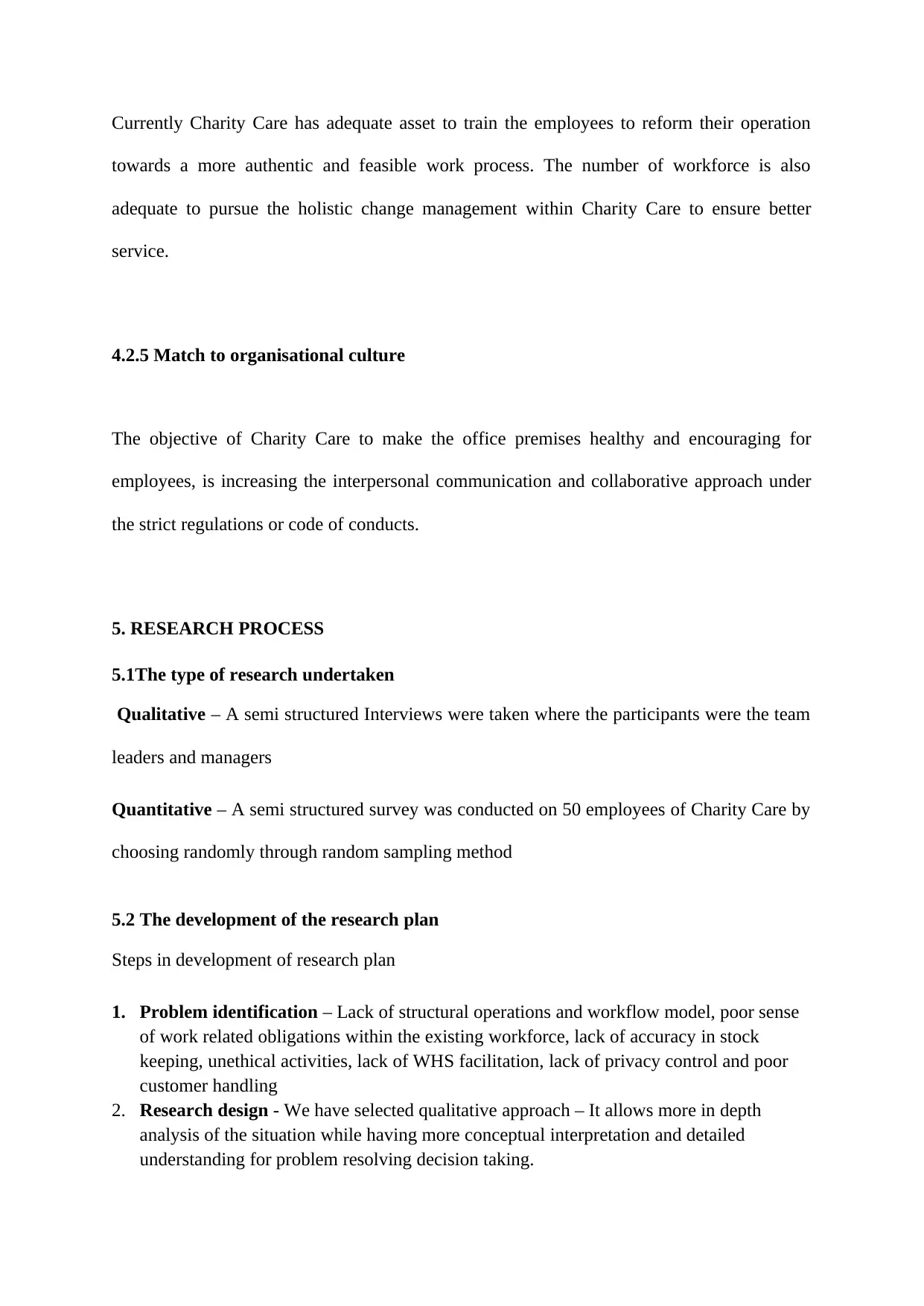
Currently Charity Care has adequate asset to train the employees to reform their operation
towards a more authentic and feasible work process. The number of workforce is also
adequate to pursue the holistic change management within Charity Care to ensure better
service.
4.2.5 Match to organisational culture
The objective of Charity Care to make the office premises healthy and encouraging for
employees, is increasing the interpersonal communication and collaborative approach under
the strict regulations or code of conducts.
5. RESEARCH PROCESS
5.1The type of research undertaken
Qualitative – A semi structured Interviews were taken where the participants were the team
leaders and managers
Quantitative – A semi structured survey was conducted on 50 employees of Charity Care by
choosing randomly through random sampling method
5.2 The development of the research plan
Steps in development of research plan
1. Problem identification – Lack of structural operations and workflow model, poor sense
of work related obligations within the existing workforce, lack of accuracy in stock
keeping, unethical activities, lack of WHS facilitation, lack of privacy control and poor
customer handling
2. Research design - We have selected qualitative approach – It allows more in depth
analysis of the situation while having more conceptual interpretation and detailed
understanding for problem resolving decision taking.
towards a more authentic and feasible work process. The number of workforce is also
adequate to pursue the holistic change management within Charity Care to ensure better
service.
4.2.5 Match to organisational culture
The objective of Charity Care to make the office premises healthy and encouraging for
employees, is increasing the interpersonal communication and collaborative approach under
the strict regulations or code of conducts.
5. RESEARCH PROCESS
5.1The type of research undertaken
Qualitative – A semi structured Interviews were taken where the participants were the team
leaders and managers
Quantitative – A semi structured survey was conducted on 50 employees of Charity Care by
choosing randomly through random sampling method
5.2 The development of the research plan
Steps in development of research plan
1. Problem identification – Lack of structural operations and workflow model, poor sense
of work related obligations within the existing workforce, lack of accuracy in stock
keeping, unethical activities, lack of WHS facilitation, lack of privacy control and poor
customer handling
2. Research design - We have selected qualitative approach – It allows more in depth
analysis of the situation while having more conceptual interpretation and detailed
understanding for problem resolving decision taking.
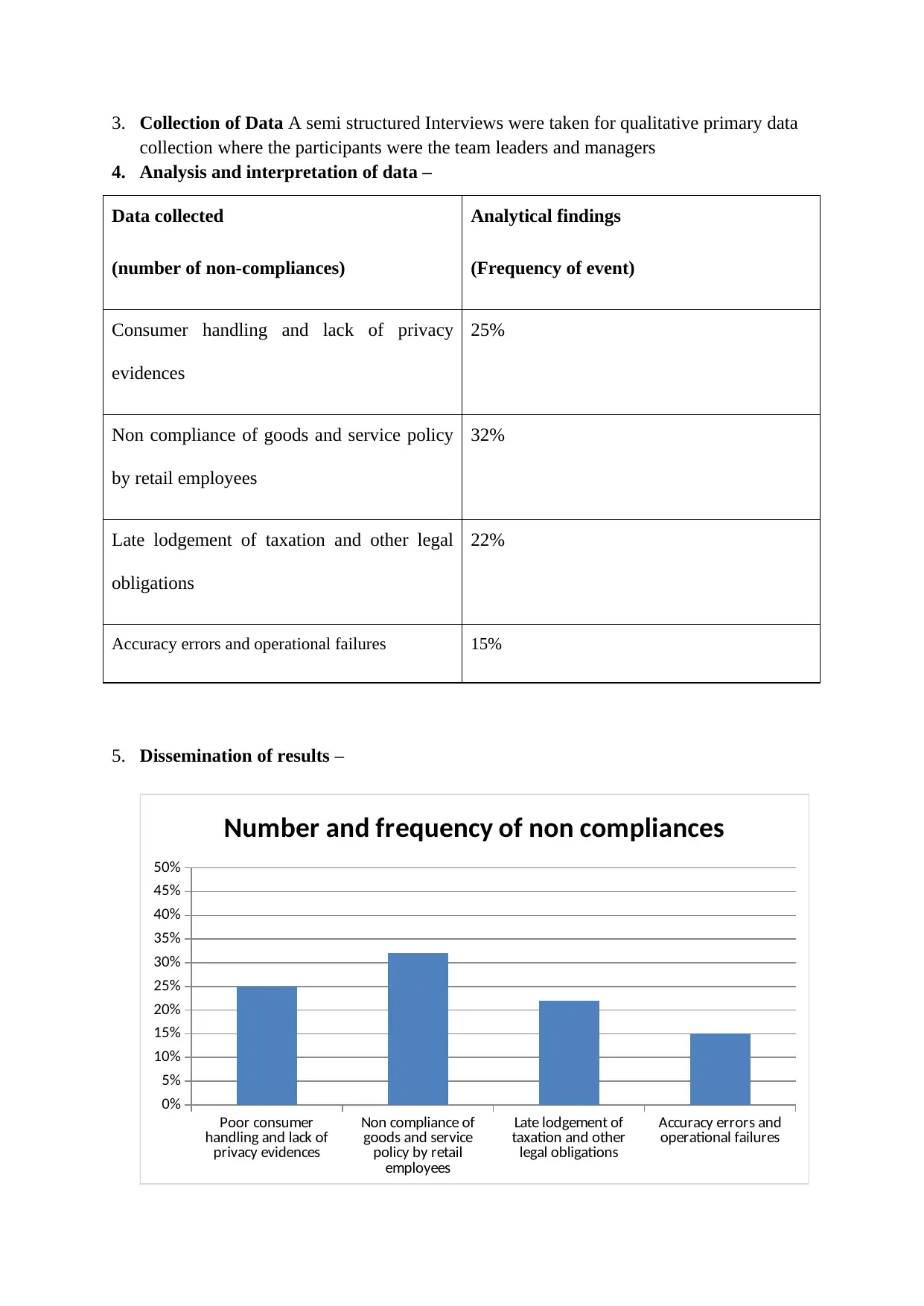
3. Collection of Data A semi structured Interviews were taken for qualitative primary data
collection where the participants were the team leaders and managers
4. Analysis and interpretation of data –
Data collected
(number of non-compliances)
Analytical findings
(Frequency of event)
Consumer handling and lack of privacy
evidences
25%
Non compliance of goods and service policy
by retail employees
32%
Late lodgement of taxation and other legal
obligations
22%
Accuracy errors and operational failures 15%
5. Dissemination of results –
Poor consumer
handling and lack of
privacy evidences
Non compliance of
goods and service
policy by retail
employees
Late lodgement of
taxation and other
legal obligations
Accuracy errors and
operational failures
0%
5%
10%
15%
20%
25%
30%
35%
40%
45%
50%
Number and frequency of non compliances
collection where the participants were the team leaders and managers
4. Analysis and interpretation of data –
Data collected
(number of non-compliances)
Analytical findings
(Frequency of event)
Consumer handling and lack of privacy
evidences
25%
Non compliance of goods and service policy
by retail employees
32%
Late lodgement of taxation and other legal
obligations
22%
Accuracy errors and operational failures 15%
5. Dissemination of results –
Poor consumer
handling and lack of
privacy evidences
Non compliance of
goods and service
policy by retail
employees
Late lodgement of
taxation and other
legal obligations
Accuracy errors and
operational failures
0%
5%
10%
15%
20%
25%
30%
35%
40%
45%
50%
Number and frequency of non compliances
Paraphrase This Document
Need a fresh take? Get an instant paraphrase of this document with our AI Paraphraser
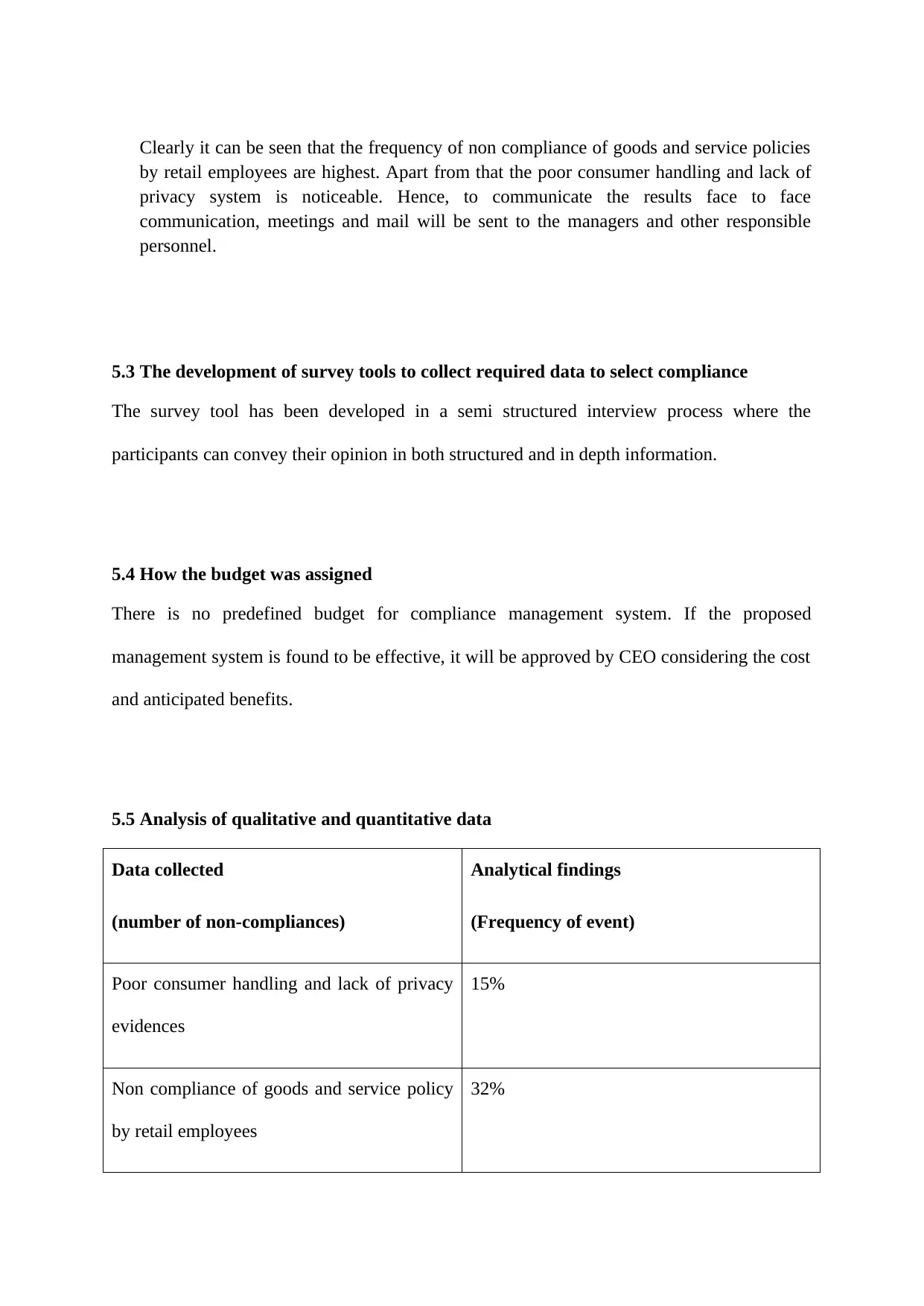
Clearly it can be seen that the frequency of non compliance of goods and service policies
by retail employees are highest. Apart from that the poor consumer handling and lack of
privacy system is noticeable. Hence, to communicate the results face to face
communication, meetings and mail will be sent to the managers and other responsible
personnel.
5.3 The development of survey tools to collect required data to select compliance
The survey tool has been developed in a semi structured interview process where the
participants can convey their opinion in both structured and in depth information.
5.4 How the budget was assigned
There is no predefined budget for compliance management system. If the proposed
management system is found to be effective, it will be approved by CEO considering the cost
and anticipated benefits.
5.5 Analysis of qualitative and quantitative data
Data collected
(number of non-compliances)
Analytical findings
(Frequency of event)
Poor consumer handling and lack of privacy
evidences
15%
Non compliance of goods and service policy
by retail employees
32%
by retail employees are highest. Apart from that the poor consumer handling and lack of
privacy system is noticeable. Hence, to communicate the results face to face
communication, meetings and mail will be sent to the managers and other responsible
personnel.
5.3 The development of survey tools to collect required data to select compliance
The survey tool has been developed in a semi structured interview process where the
participants can convey their opinion in both structured and in depth information.
5.4 How the budget was assigned
There is no predefined budget for compliance management system. If the proposed
management system is found to be effective, it will be approved by CEO considering the cost
and anticipated benefits.
5.5 Analysis of qualitative and quantitative data
Data collected
(number of non-compliances)
Analytical findings
(Frequency of event)
Poor consumer handling and lack of privacy
evidences
15%
Non compliance of goods and service policy
by retail employees
32%
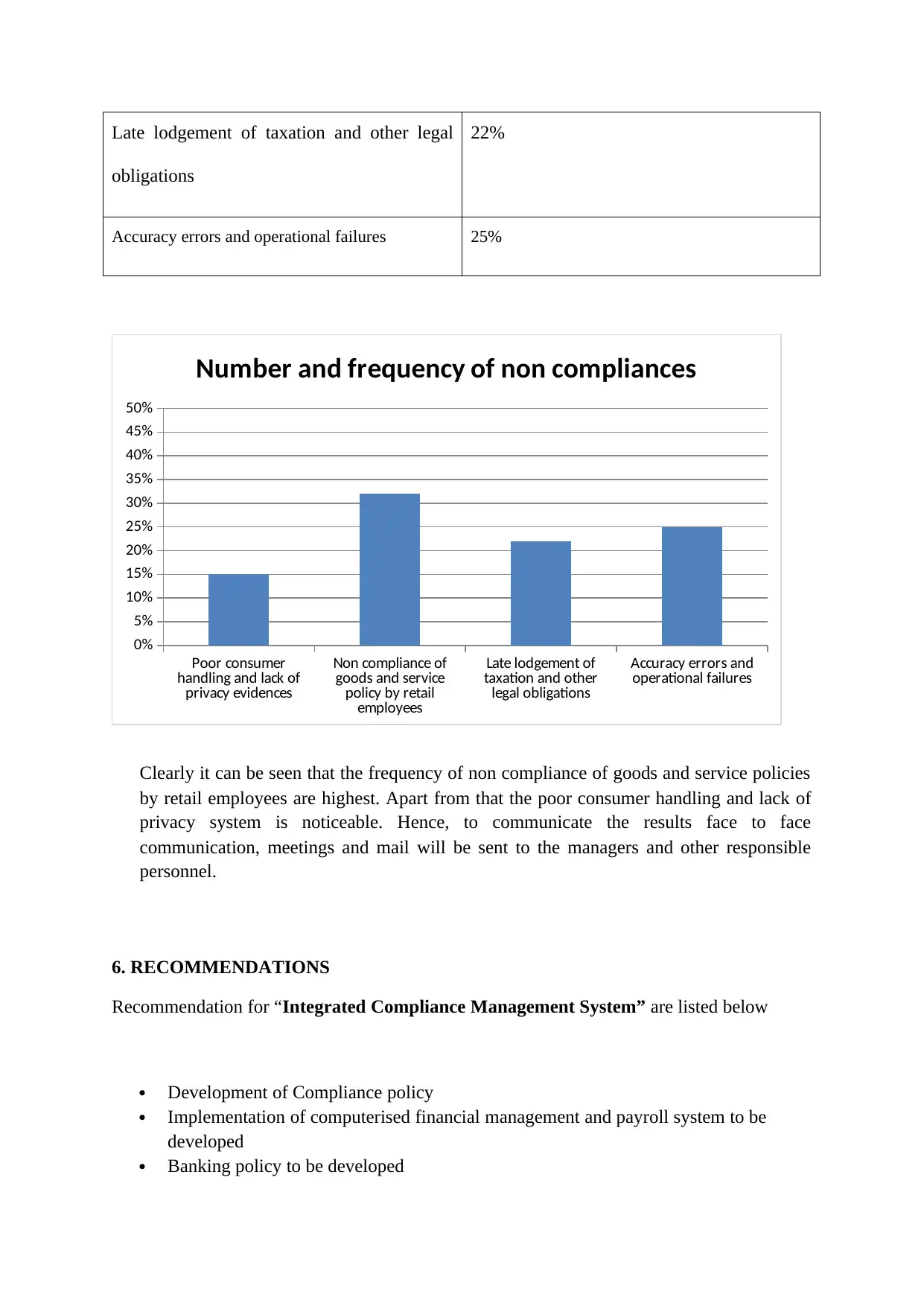
Late lodgement of taxation and other legal
obligations
22%
Accuracy errors and operational failures 25%
Poor consumer
handling and lack of
privacy evidences
Non compliance of
goods and service
policy by retail
employees
Late lodgement of
taxation and other
legal obligations
Accuracy errors and
operational failures
0%
5%
10%
15%
20%
25%
30%
35%
40%
45%
50%
Number and frequency of non compliances
Clearly it can be seen that the frequency of non compliance of goods and service policies
by retail employees are highest. Apart from that the poor consumer handling and lack of
privacy system is noticeable. Hence, to communicate the results face to face
communication, meetings and mail will be sent to the managers and other responsible
personnel.
6. RECOMMENDATIONS
Recommendation for “Integrated Compliance Management System” are listed below
Development of Compliance policy
Implementation of computerised financial management and payroll system to be
developed
Banking policy to be developed
obligations
22%
Accuracy errors and operational failures 25%
Poor consumer
handling and lack of
privacy evidences
Non compliance of
goods and service
policy by retail
employees
Late lodgement of
taxation and other
legal obligations
Accuracy errors and
operational failures
0%
5%
10%
15%
20%
25%
30%
35%
40%
45%
50%
Number and frequency of non compliances
Clearly it can be seen that the frequency of non compliance of goods and service policies
by retail employees are highest. Apart from that the poor consumer handling and lack of
privacy system is noticeable. Hence, to communicate the results face to face
communication, meetings and mail will be sent to the managers and other responsible
personnel.
6. RECOMMENDATIONS
Recommendation for “Integrated Compliance Management System” are listed below
Development of Compliance policy
Implementation of computerised financial management and payroll system to be
developed
Banking policy to be developed
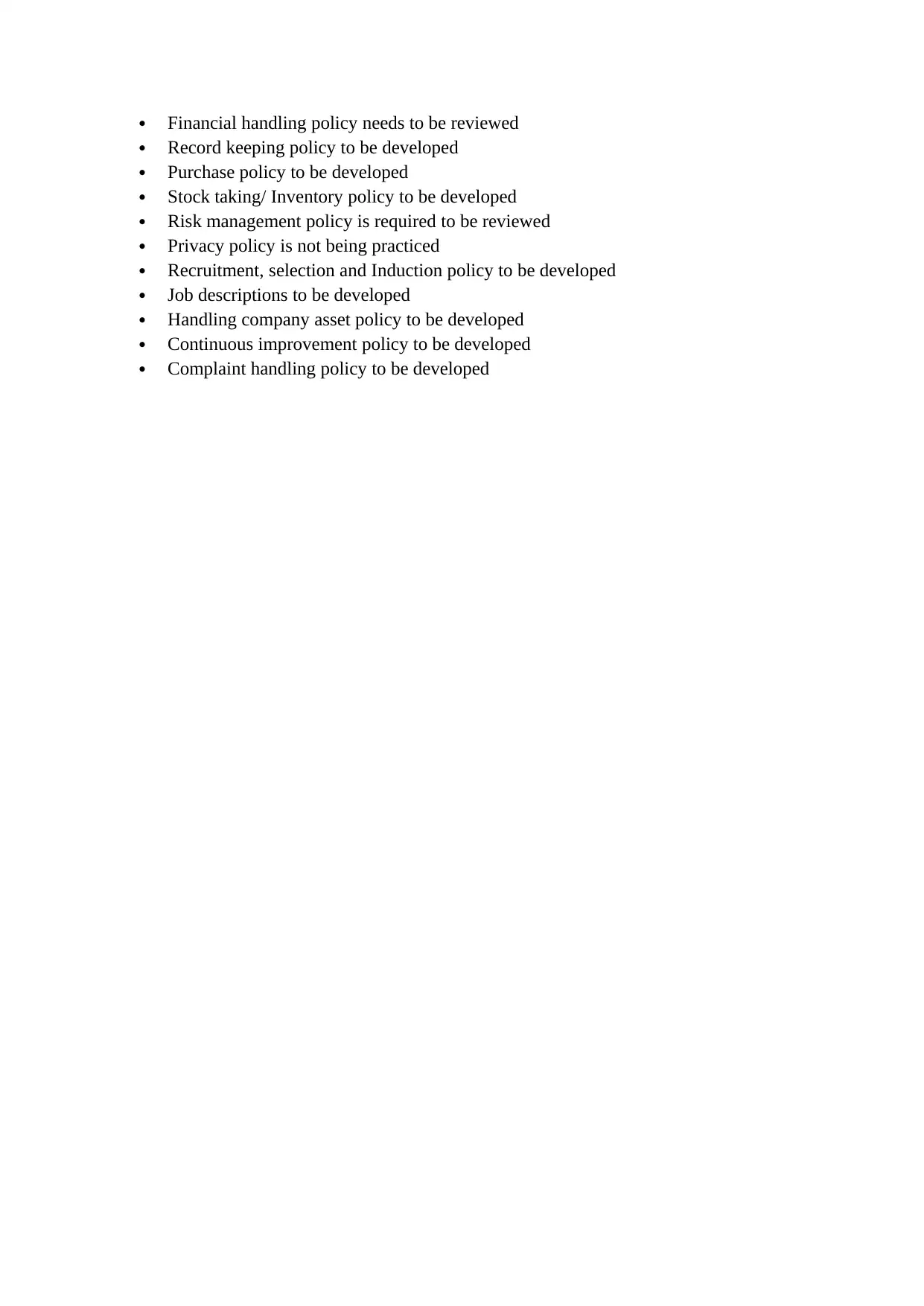
Financial handling policy needs to be reviewed
Record keeping policy to be developed
Purchase policy to be developed
Stock taking/ Inventory policy to be developed
Risk management policy is required to be reviewed
Privacy policy is not being practiced
Recruitment, selection and Induction policy to be developed
Job descriptions to be developed
Handling company asset policy to be developed
Continuous improvement policy to be developed
Complaint handling policy to be developed
Record keeping policy to be developed
Purchase policy to be developed
Stock taking/ Inventory policy to be developed
Risk management policy is required to be reviewed
Privacy policy is not being practiced
Recruitment, selection and Induction policy to be developed
Job descriptions to be developed
Handling company asset policy to be developed
Continuous improvement policy to be developed
Complaint handling policy to be developed
1 out of 16
Related Documents
Your All-in-One AI-Powered Toolkit for Academic Success.
+13062052269
info@desklib.com
Available 24*7 on WhatsApp / Email
![[object Object]](/_next/static/media/star-bottom.7253800d.svg)
Unlock your academic potential
© 2024 | Zucol Services PVT LTD | All rights reserved.





